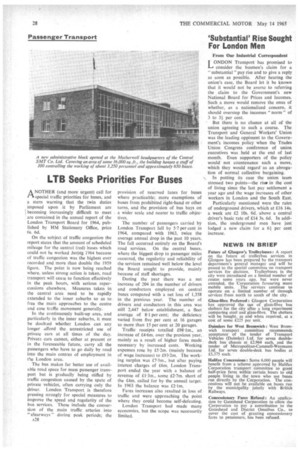LTB Seeks Priorities For Buses
Page 30

If you've noticed an error in this article please click here to report it so we can fix it.
ANOTHER (and more urgent) call for special traffic priorities for buses, and a stern warning that the twin duties imposed upon it by Parliament are becoming increasingly difficult to meet are contained in the annual report of the London Transport Board for 1964, published by HM Stationery Office, price 6s. 6d.
On the subject of traffic congestion the report states that the amount of scheduled mileage for the central (red) buses which could not be worked Juring 1964 because of traffic congestion was the highest ever recorded and more than double the 1959 figure. The point is now being reached where, unless strong action is taken, road transport will cease to function effectively in the peak hours, with serious repercussions elsewhere. Measures taken in the central area need to be rapidly extended to the inner suburbs so as to free the main approaches to the centre and ease traffic movement generally.
In the continuously built-up area, and particularly in the inner suburbs, it must be dotibed whether London can any longer afford the unrestricted use of private cars at all times of the day. Private cars cannot, either at present or in the foreseeable future, carry all the passengers who have to go daily by road into the main centres of employment in the London area.
The bus makes far better use of available road space for mass passenger transport but is gradually being stifled by traffic congestion caused by the spate of private vehicles, often carrying only the driver. London Transport is therefore pressing strongly for special measures to improve the speed and regularity of the bus services. These include the conversion of the main traffic arteries into " clearways " during peak periods; the
A28 provision of reserved lanes for buses where practicable; more exemptions of buses from prohibited right-hand or other turns, and the provision of bus bays on a wider scale and nearer to traffic objectives.
The number of passengers carried by London Transport fell by 5.7 per cent in 1964, compared with 1963, twice the average annual drop in the past 10 years. The fall occurred entirely on the Board's road services. On the central buses, where the biggest drop in passenger miles occurred, the regularity and reliability of the services remained well below the level the Board sought to provide, mainly because of staff shortages.
During the year there was a net increase of 204 in the number of drivers and conductors employed on central buses compared with a net loss of 1,358 in the previous year. The number of drivers and conductors in this area was still 2,447 below establishment, a fleet average of 8-1 per cent; the deficiency varied from five per cent at 16 garages to more than 15 per cent at 20 garages.
Traffic receipts totalled £98.1ra., an increase of £4.6nt over the previous year, mainly as a result of higher fares made necessary by increased costs. Working expenses rose by 15-2m, (mainly because of wage increases) to .193-2m. The working surplus was .17.3m., but after paying interest charges of 16m. London Transport ended the year with a balance of revenue of 11-3m., some 12-7m. short of the 14m. called for by the annual target. In 1963 the balance was 12-1m.
Fares increases also resulted in loss of traffic and were approaching the point where they could become self-defeating.
London Transport had made many economies, but the scope was necessarily limited.




















































































































